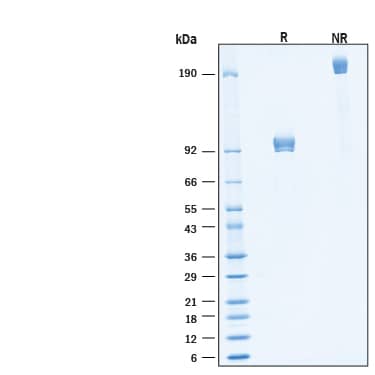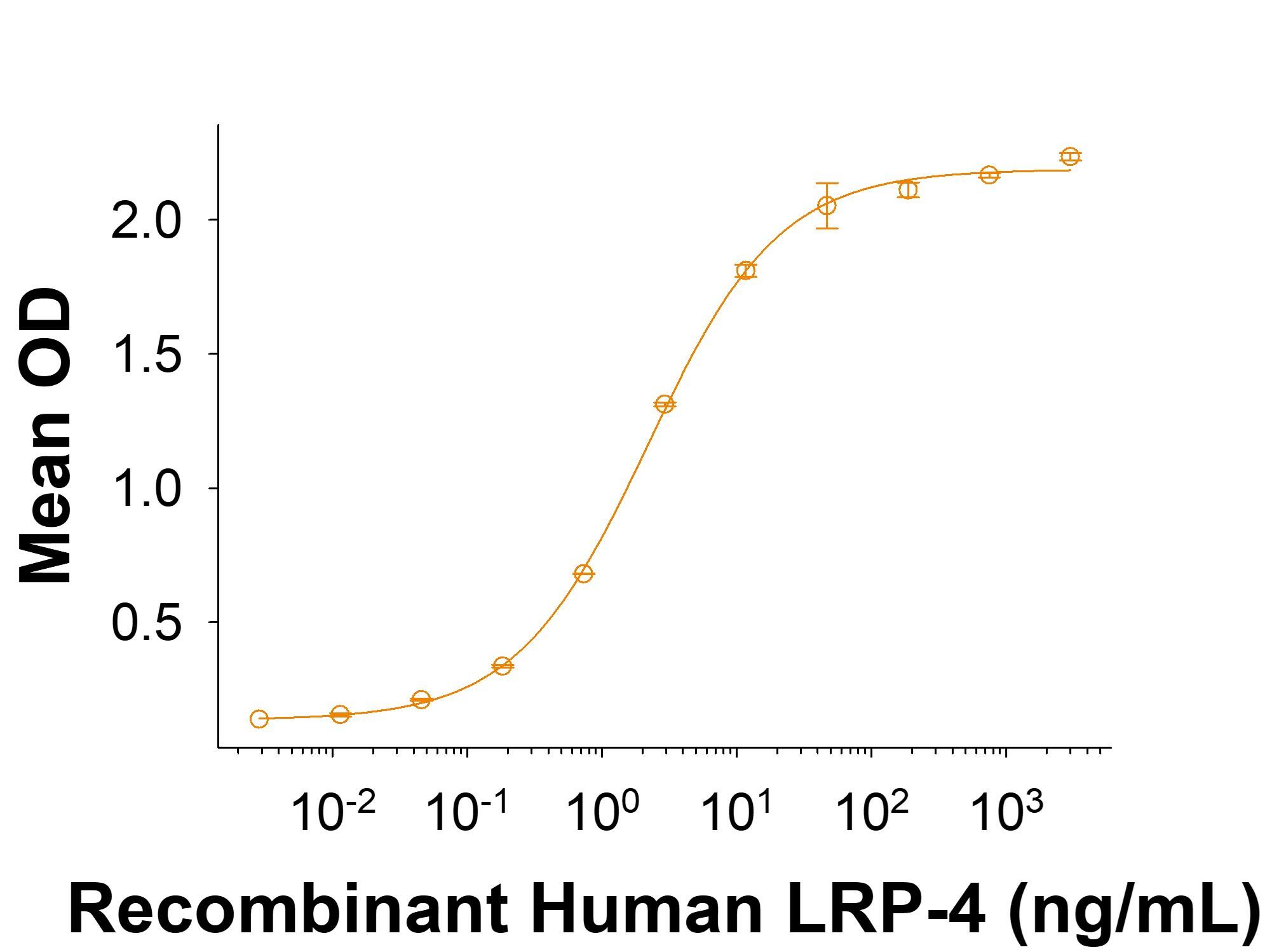Recombinant Human MuSK Fc Chimera Avi-tag Protein, CF
R&D Systems, part of Bio-Techne | Catalog # AVI9810
Biotinylated

Key Product Details
Learn more about Avi-tag Biotinylated Proteins
Source
CHO
Structure / Form
Disulfide-linked homodimer
Biotinylated via Avi-tag
Biotinylated via Avi-tag
Conjugate
Biotin
Applications
Bioactivity
Product Specifications
Source
Chinese Hamster Ovary cell line, CHO-derived human MuSK protein
| Human MuSK (Leu24-Thr495) Accession # O15146.1 |
IEGRMD | Human IgG1 (Pro100-Lys330) |
Avi-tag |
| N-terminus | C-terminus | ||
Purity
>95%, by SDS-PAGE visualized with Silver Staining and quantitative densitometry by Coomassie® Blue Staining.
Endotoxin Level
<0.10 EU per 1 μg of the protein by the LAL method.
N-terminal Sequence Analysis
Leu24
Predicted Molecular Mass
80 kDa
SDS-PAGE
87-102 kDa, under reducing conditions.
Activity
Measured by its binding ability in a functional ELISA.
When Biotinylated Recombinant Human MuSK Fc Chimera Avi-tag (Catalog # AVI9810) is immobilized onto a Streptavidin coated plate (Catalog # CP004) at 2 µg/mL (100 µL/well), in the presence of Recombinant Human Agrin (Catalog # 6624-AG), it binds to Recombinant Human LRP-4 (Catalog # 5948-LR) with an ED50 of 0.600-4.80 ng/mL.
When Biotinylated Recombinant Human MuSK Fc Chimera Avi-tag (Catalog # AVI9810) is immobilized onto a Streptavidin coated plate (Catalog # CP004) at 2 µg/mL (100 µL/well), in the presence of Recombinant Human Agrin (Catalog # 6624-AG), it binds to Recombinant Human LRP-4 (Catalog # 5948-LR) with an ED50 of 0.600-4.80 ng/mL.
Scientific Data Images for Recombinant Human MuSK Fc Chimera Avi-tag Protein, CF
Biotinylated Recombinant Human MuSK Fc Chimera Avi-tag Protein Binding Activity.
When Biotinylated Recombinant Human MuSK Fc Chimera Avi-tag Protein (Catalog # AVI9810) is immobilized onto a Streptavidin coated plate (CP004) at 2 µg/mL (100 µL/well), in the presence of Recombinant Human Agrin (6624-AG), it binds to Recombinant Human LRP-4 (5948-LR) with an ED50 of 0.600-4.80 ng/mL.Biotinylated Recombinant Human MuSK Fc Chimera Avi-tag Protein SDS-PAGE.
2 μg/lane of Biotinylated Recombinant Human MuSK Fc Chimera Avi-tag Protein (Catalog # AVI9810) was resolved with SDS-PAGE under reducing (R) and non-reducing (NR) conditions and visualized by Coomassie® Blue staining, showing bands at 87-102 kDa and 170-200 kDa, respectively.Formulation, Preparation and Storage
AVI9810
| Formulation | Lyophilized from a 0.2 μm filtered solution in PBS with Trehalose. |
| Reconstitution | Reconstitute at 500 μg/mL in PBS. |
| Shipping | The product is shipped with polar packs. Upon receipt, store it immediately at the temperature recommended below. |
| Stability & Storage | Use a manual defrost freezer and avoid repeated freeze-thaw cycles.
|
Background: MuSK
References
- Valenzuela, D.M. et al. (1995) Neuron. 15:573.
- Finn, A.J. et al. (2003) Nat. Neurosci. 6:717.
- Nasrin, F. et al. (2014) Sci. Rep. 4:6841.
- Kim, N. et al. (2008) Cell 135:334.
- Banerjee, S. et al. (2011) Development 138:3287.
- Amenta, A.R. et al. (2012) J Neurosci 32:2324.
- Otsuka, K. et al (2015) Scientific Reports. 5:13928.
- Zhang, B. et al. (2008) Neuron 60:285.
- Zhang, W. et al. (2011) J Biol Chem. 286(47):40624.
- Burden, S.J. et al. (2017) CSH Perspectives Biol. 5:a009167.
Long Name
Muscle-specific Receptor Tyrosine Kinase
Alternate Names
EC 2.7.10, EC 2.7.10.1, MGC126323, MGC126324, muscle, skeletal, receptor tyrosine kinase, MuSK, skeletal receptor tyrosine-protein kinase
Gene Symbol
MUSK
Additional MuSK Products
Product Documents for Recombinant Human MuSK Fc Chimera Avi-tag Protein, CF
Product Specific Notices for Recombinant Human MuSK Fc Chimera Avi-tag Protein, CF
For research use only
